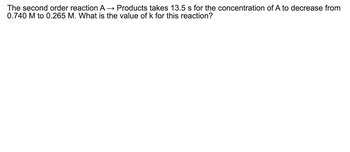
Chemistry
10th Edition
ISBN: 9781305957404
Author: Steven S. Zumdahl, Susan A. Zumdahl, Donald J. DeCoste
Publisher: Cengage Learning
expand_more
expand_more
format_list_bulleted
Question

Transcribed Image Text:The second order reaction A→ Products takes 13.5 s for the concentration of A to decrease from
0.740 M to 0.265 M. What is the value of k for this reaction?
Expert Solution
This question has been solved!
Explore an expertly crafted, step-by-step solution for a thorough understanding of key concepts.
Step by stepSolved in 3 steps with 11 images

Knowledge Booster
Learn more about
Need a deep-dive on the concept behind this application? Look no further. Learn more about this topic, chemistry and related others by exploring similar questions and additional content below.Similar questions
- The second order reaction A → Products takes 13.5 s for the concentration of A to decrease from 0.740 M to 0.213 M. What is the value of k for this reaction?arrow_forward5. Study the following reactions: 2H2O2⇌2H2O+O22H2O2⇌catalyst2H2O+O2Reaction 1: uncatalyzedReaction 2: catalyzed If the two reactions occur at the same temperature, which statements are true? Select all that apply. The catalyzed reaction will reach equilibrium faster than the uncatalyzed reaction. The uncatalyzed reaction will reach equilibrium faster than the catalyzed reaction. The equilibrium position of the catalyzed reaction is greater than that of Reaction 1. The equilibrium position is the same in both the catalyzed reaction and the uncatalyzed reaction. The equilibrium position of the catalyzed reaction is shifted toward the products side. The equilibrium position of the catalyzed reaction is shifted toward the reactants side.arrow_forwardk=? k=?arrow_forward
- For the reaction A ⇌ 2B, the initial concentration of A is 1.0 M and the initial concentration of B is 0 M. After 5 minutes the [A] has decreased to 0.60 M and does not change any further. Draw a graph for [A] vs. time over the span of 10 minutesarrow_forwardPlease don't provide handwriting solutionarrow_forwardConsider the reaction: Zn (s) + H2SO4 (g) ZnSO4 (aq) + H2(g) at 60°C Explain with reason the effect of the following on the rate of this reaction: a) Zinc metal is broken down to small pieces in the form of powder. 1M b) Concentration of H2SO4 is increased from 0.0125 M to 0.025 Marrow_forward
- *** S 19. Solid ammonium hydrogen sulfide is introduced into a 2.00-L flask, and the flask is şealed. If this solid decomposes according to the equation below DAUS Ca Nothange NH4HS(s) NH3(g) + H₂S(g), Kp = 0.108 at 25°C, what is the minimum mass of ammonium hydrogen sulfide that must be present in the flask initially if equilibrium is to be established at 25°C? A) 0.917 g B) 1.37 g C) 2.74 g D) 0.581 g E) 0.452 garrow_forwardIn the following reaction mechanism: Cl + O3--> ClO + O2 ClO + O3 --> Cl + 2O2 The intermediate is ____ and the catalyst is________ O3, Cl ClO, Cl ClO, O3 Cl, ClOarrow_forwardIf a catalyst is added, what direction would the equilibrium position shift to?arrow_forward
arrow_back_ios
arrow_forward_ios
Recommended textbooks for you
 ChemistryChemistryISBN:9781305957404Author:Steven S. Zumdahl, Susan A. Zumdahl, Donald J. DeCostePublisher:Cengage Learning
ChemistryChemistryISBN:9781305957404Author:Steven S. Zumdahl, Susan A. Zumdahl, Donald J. DeCostePublisher:Cengage Learning ChemistryChemistryISBN:9781259911156Author:Raymond Chang Dr., Jason Overby ProfessorPublisher:McGraw-Hill Education
ChemistryChemistryISBN:9781259911156Author:Raymond Chang Dr., Jason Overby ProfessorPublisher:McGraw-Hill Education Principles of Instrumental AnalysisChemistryISBN:9781305577213Author:Douglas A. Skoog, F. James Holler, Stanley R. CrouchPublisher:Cengage Learning
Principles of Instrumental AnalysisChemistryISBN:9781305577213Author:Douglas A. Skoog, F. James Holler, Stanley R. CrouchPublisher:Cengage Learning Organic ChemistryChemistryISBN:9780078021558Author:Janice Gorzynski Smith Dr.Publisher:McGraw-Hill Education
Organic ChemistryChemistryISBN:9780078021558Author:Janice Gorzynski Smith Dr.Publisher:McGraw-Hill Education Chemistry: Principles and ReactionsChemistryISBN:9781305079373Author:William L. Masterton, Cecile N. HurleyPublisher:Cengage Learning
Chemistry: Principles and ReactionsChemistryISBN:9781305079373Author:William L. Masterton, Cecile N. HurleyPublisher:Cengage Learning Elementary Principles of Chemical Processes, Bind...ChemistryISBN:9781118431221Author:Richard M. Felder, Ronald W. Rousseau, Lisa G. BullardPublisher:WILEY
Elementary Principles of Chemical Processes, Bind...ChemistryISBN:9781118431221Author:Richard M. Felder, Ronald W. Rousseau, Lisa G. BullardPublisher:WILEY

Chemistry
Chemistry
ISBN:9781305957404
Author:Steven S. Zumdahl, Susan A. Zumdahl, Donald J. DeCoste
Publisher:Cengage Learning

Chemistry
Chemistry
ISBN:9781259911156
Author:Raymond Chang Dr., Jason Overby Professor
Publisher:McGraw-Hill Education

Principles of Instrumental Analysis
Chemistry
ISBN:9781305577213
Author:Douglas A. Skoog, F. James Holler, Stanley R. Crouch
Publisher:Cengage Learning

Organic Chemistry
Chemistry
ISBN:9780078021558
Author:Janice Gorzynski Smith Dr.
Publisher:McGraw-Hill Education

Chemistry: Principles and Reactions
Chemistry
ISBN:9781305079373
Author:William L. Masterton, Cecile N. Hurley
Publisher:Cengage Learning

Elementary Principles of Chemical Processes, Bind...
Chemistry
ISBN:9781118431221
Author:Richard M. Felder, Ronald W. Rousseau, Lisa G. Bullard
Publisher:WILEY